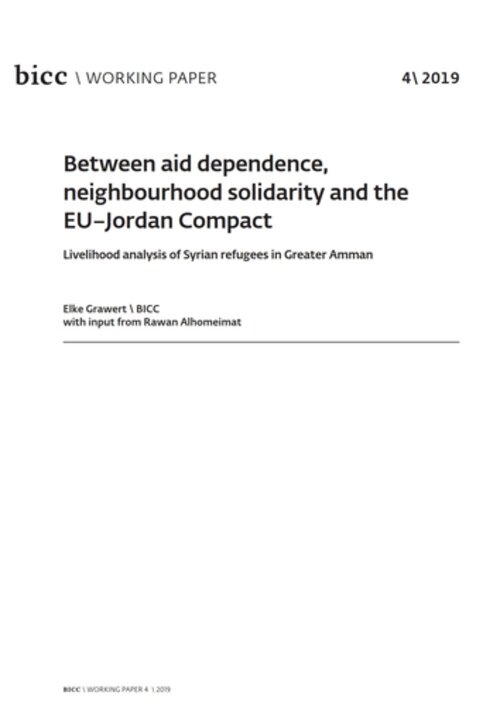Publications
Between aid dependence, neighbourhood solidarity and the EU-Jordan Compact. Livelihood analysis of Syrian refugees in Greater Amman
Release Date
2019-03
Language
- English
Topics
- –
Jordan, with a population of about ten million, hosts 1.3 million Syrians of whom 670,000 are UNHCR-registered refugees, as well as nearly 85,000 registered refugees from other countries and is thus one of the countries with the highest proportion of refugees in the world. Most of them (83 per cent) are staying outside camps and many have rented flats mainly in the Jordanian capital Amman and its surroundings.
The particular conditions for refugees from Syria staying in a receiving area among people with a history of protracted displacement are in the focus of this Working Paper. How do refugees from Syria secure their livelihood in the neighbourhoods of Palestinians who share the experience of a volatile legal status and limited economic rights? Does the EU–Jordan Compact improve Syrians’ livelihoods?
These questions are addressed by an analytical livelihood approach that includes social relationships as a significant conducive or constraining factor for refugees’ agency (ability to act) in making use of local livelihood options. The findings generated in field research between November 2016 and July 2017 reveal dynamics within the Palestinian receiving community that have shifted from empathy and solidarity to more ambiguous interaction up to the exploitation and seclusion of refugees. The Paper shows how self-organised assistance groups of Jordanians with Palestinian origin take care of refugees from Syria in dire need for help, no matter what legal status they have. They support some refugees in regaining their agency and thus contribute to securing their livelihood. The central argument of this Paper is that the agenda of international aid and development agencies of enhancing resilience and promoting self-reliance of refugees does not strengthen refugees’ agency. Instead of considering the refugees’ own priorities and intentions about their livelihood, it pre-designs basic needs to different refugee groups and attempts to integrate them into a presumed market economy that in fact is distorted for political purposes (mainly shielding Jordanians from foreign competitors).
PDF-Download
wp_4_19_web.pdf
[English] (659.9 KB)

Cite as
@techreport{Grawert2019,
author = "Elke Grawert",
title = "Between aid dependence, neighbourhood solidarity and the EU-Jordan Compact. Livelihood analysis of Syrian refugees in Greater Amman",
latexTitle = "Between aid dependence, neighbourhood solidarity and the EU-Jordan Compact. Livelihood analysis of Syrian refugees in Greater Amman",
publisher = "BICC",
number = "4",
institution = "BICC",
type = "BICC Working paper",
year = "2019",
isbn = "2521-781X",
address = "Bonn",
}
Document-Type
BICC Working paper
Publisher
BICC
Place
Bonn
ISSN/ISBN
2521-781X
Countries/Region
Jordan



